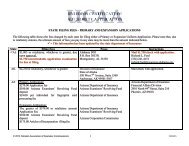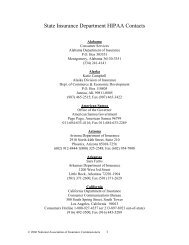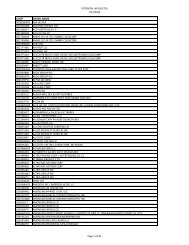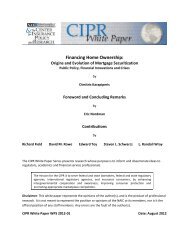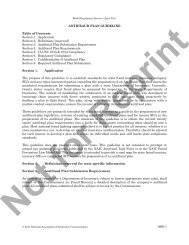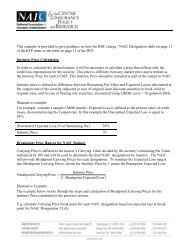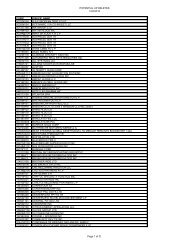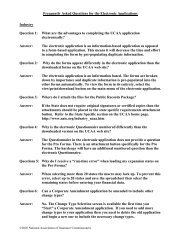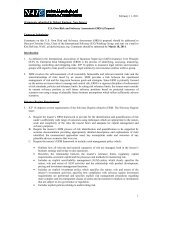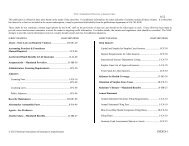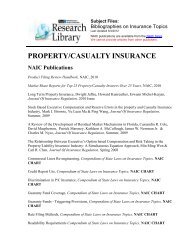CUSIP Number
CUSIP Number
CUSIP Number
Create successful ePaper yourself
Turn your PDF publications into a flip-book with our unique Google optimized e-Paper software.
<strong>CUSIP</strong> NUMBER<br />
NAIC Publicly Traded Securities Listing Definitions<br />
<strong>CUSIP</strong> <strong>Number</strong><br />
Example: 008000AA7<br />
The <strong>CUSIP</strong> number is used to identify securities. Every publicly traded security in the Valuation<br />
of Securities Database has a unique <strong>CUSIP</strong> number.<br />
<strong>CUSIP</strong> numbers are 9 characters long. The first 8 characters of the <strong>CUSIP</strong> number uniquely<br />
identify a security. The first 6 characters (Issuer <strong>Number</strong>) represent the Issuer of a security, the<br />
next two characters (Issue <strong>Number</strong>) represent the individual issue, and the last character is a<br />
check digit.<br />
For example 008000AA7 is the full 9 character <strong>CUSIP</strong> number<br />
008000 = the issuer (e.g., ACF Co.)<br />
AA = the issue (e.g. Senior note)<br />
7 = Check digit<br />
Private Placement <strong>Number</strong> (PPN)<br />
Example: 00800*AA7<br />
A private placement number is a number assigned by S&P’s <strong>CUSIP</strong> Service Bureau that is issued<br />
for a security that is not traded on the public markets. PPNs can be recognized by the existence<br />
of a #, @ or * in the 6th, 7th, or 8th position of the <strong>CUSIP</strong> number. If the issuer is a private<br />
company, the #, @ or * will appear in the 6th position of the PPN. For privately traded issues of<br />
public entities, the #, @, or * will appear in either the 7th or 8th position of the PPN.<br />
For example 00800*AA7 is the full 9 character PPN<br />
00800* = the issuer (e.g., Private Co.)<br />
AA = the issue (e.g. Senior note)<br />
7 = Check digit<br />
CINS <strong>Number</strong><br />
Example: F08000AA7<br />
<strong>CUSIP</strong> International <strong>Number</strong>ing System (CINS) numbers are used to identify securities issued in<br />
foreign markets. These numbers can be either public or private issues. They can be recognized<br />
by the presence of a letter in the first position of the CINS number.<br />
The following letters identify the domiciliary country of the issuer:<br />
A = Austria<br />
B = Belgium<br />
C = Canada<br />
D = Germany<br />
E = Spain F = France<br />
G = United Kingdom<br />
H = Switzerland<br />
J = Japan<br />
K = Denmark<br />
L = Luxembourg<br />
M = Mid East<br />
N = Netherlands<br />
P = South America<br />
Q = Australia<br />
R = Norway<br />
S = South Africa<br />
T = Italy<br />
U = USA<br />
- 1 -
V = Africa – Other<br />
X = Europe – Other<br />
Y = Asia<br />
NAIC Publicly Traded Securities Listing Definitions<br />
For example F08000AA7 is the full 9 character CINS <strong>Number</strong><br />
00800* = the issuer (e.g., Public French Co.)<br />
AA = the issue (e.g. Senior note)<br />
7 = Check digit<br />
VOS DESIGNATION<br />
Definition of NAIC Designation Categories<br />
NAIC Designations are the specific alphanumeric symbols in use by the NAIC SVO to denote a<br />
category of credit quality. When applied to Bonds and to derivative counterparties, the NAIC<br />
Designation appears without a prefix. The valuation indicator P is placed in front of the NAIC<br />
Designation to indicate that the SVO has classified the security as a perpetual preferred stock.<br />
The valuation indicator RP is placed in front of the NAIC Designation to indicate that the SVO has<br />
classified the security as a redeemable preferred stock for the purposes of valuation under SAP.<br />
NAIC 1 is assigned to obligations exhibiting the highest quality. Credit risk is at its lowest and the<br />
issuer’s credit profile is stable. This means that interest, principal or both will be paid in<br />
accordance with the contractual agreement and that repayment of principal is well protected.<br />
An NAIC 1 obligation should be eligible for the most favorable treatment provided under the NAIC<br />
Financial Conditions Framework.<br />
NAIC 2 is assigned to obligations of high quality. Credit risk is low but may increase in the<br />
intermediate future and the issuer’s credit profile are reasonably stable. This means that for the<br />
present, the obligation’s protective elements suggest a high likelihood that interest, principal or<br />
both will be paid in accordance with the contractual agreement, but there are suggestions that an<br />
adverse change in circumstances or economic, financial or business conditions will affect the<br />
degree of protection and lead to a weakened capacity to pay.<br />
An NAIC 2 obligation should be eligible for relatively favorable treatment under the NAIC<br />
Financial Conditions Framework.<br />
NAIC 3 is assigned to obligations of medium quality. Credit risk is intermediate and the issuer’s<br />
credit profile has elements of instability. These obligations exhibit speculative elements. This<br />
means that the likelihood that interest, principal or both will be paid in accordance with the<br />
contractual agreement is reasonable for the present, but an exposure to an adverse change in<br />
circumstances or economic, financial or business conditions would create an uncertainty about<br />
the issuer’s capacity to make timely payments.<br />
An NAIC 3 obligation should be eligible for less favorable treatment under the NAIC Financial<br />
Conditions Framework.<br />
NAIC 4 is assigned to obligations of low quality. Credit risk is high and the issuer’s credit profile is<br />
volatile. These obligations are highly speculative, but currently the issuer has the capacity to meet<br />
its obligations. This means that the likelihood that interest, principal or both will be paid in<br />
accordance with the contractual agreement is low and that an adverse change in circumstances<br />
or business, financial or economic conditions would accelerate credit risk, leading to a significant<br />
impairment in the issuer’s capacity to make timely payments.<br />
- 2 -
NAIC Publicly Traded Securities Listing Definitions<br />
An NAIC 4 obligation should be accorded stringent treatment under the NAIC Financial<br />
Conditions Framework.<br />
NAIC 5 is assigned to obligations of the lowest credit quality, which are not in or near default.<br />
Credit risk is at its highest and credit profile is highly volatile, but currently the issuer has the<br />
capacity to meet its obligations. This means that the likelihood that interest, principal or both will<br />
be paid in accordance with the contractual agreement is significantly impaired given any adverse<br />
business, financial or economic conditions.<br />
An NAIC 5 Designation suggests a very high probability of default. An NAIC 5 obligation should<br />
incur more stringent treatment under the NAIC Financial Conditions Framework.<br />
NAIC 6 is assigned to obligations that are in or near default. This means that payment of interest,<br />
principal or both is not being made, or will not be made, in accordance with the contractual<br />
agreement.<br />
An NAIC 6 obligation should incur the most severe treatment under the NAIC<br />
Financial Conditions Framework.<br />
NAIC Designations Related to the Special Reporting Instruction<br />
NAIC 5* is assigned by the SVO to certain obligations when an insurer certifies: (1) that<br />
documentation necessary to permit a full credit analysis of a security does not exist and (2) the<br />
issuer or obligor is current on all contracted interest and principal payments and (3) the insurer<br />
has an actual expectation of ultimate repayment of all contracted interest and principal. This use<br />
of an NAIC 5* Designation is connected with the Special Reporting Instruction contained in Part<br />
Two, Section 5(b) of NAIC Purposes and Procedures manual. The NAIC 5* Designation is also<br />
assigned to certain securities pursuant to policy decisions adopted by the Valuation of Securities<br />
Task Force. Securities with NAIC 5* Designations are deemed to possess the credit<br />
characteristics of securities assigned an NAIC 5 Designation. Therefore a security assigned an<br />
NAIC 5* Designation should incur the same regulatory treatment associated with an NAIC 5<br />
Designation. The asterisk (*) after the quality indicator 5 distinguishes the NAIC 5* Designation<br />
from the NAIC 5 Designation that is only assigned by the SVO after a full credit analysis.<br />
NAIC 6* is assigned by an insurer to an obligation in lieu of reporting the obligation with<br />
appropriate documentation to the SVO for a full credit analysis or filing the certification required<br />
for obtaining an NAIC 5* Designation. This use of an NAIC 6* Designation is connected with the<br />
Special Reporting Instruction contained in Part Two, Section 5(b) of NAIC Purposes and<br />
Procedures manual An NAIC 6* Designation is also assigned by the SVO to an obligation that<br />
was assigned an NAIC 5* Designation in a given year if no Subsequent Report is received by the<br />
SVO. Securities with NAIC 6* Designations are deemed to possess the credit characteristics of<br />
securities assigned an NAIC 6 Designation. Therefore a security assigned an NAIC 6*<br />
Designation should incur the same regulatory treatment associated with an NAIC 6 Designation.<br />
The asterisk (*) after the quality indicator 6 distinguishes the NAIC 6* Designation from an NAIC<br />
6 Designation that is only assigned by the SVO after a full credit analysis.<br />
Valuation Indicators<br />
Pursuant to Part Three, Section 1(b) of NAIC Purposes and Procedures manual, SVO is required<br />
to classify preferred stock as either perpetual or redeemable. Valuation Indicators show the<br />
classification decision of the SVO and are to be used by insurers to determine a SAP valuation<br />
method for preferred stock.<br />
P means perpetual and is a valuation indicator used to classify a preferred stock as perpetual,<br />
pursuant to Part Three, Section 1(b) of NAIC Purposes and Procedures manual. The valuation<br />
indicator P means that the issuer of the preferred stock is not obligated to redeem the issue, the<br />
holder of the preferred stock does not have a right to put the preferred stock to the issuer or that<br />
- 3 -
NAIC Publicly Traded Securities Listing Definitions<br />
there is no other equivalent right. The P valuation indicator is assigned for the purposes outlined<br />
in Statement of Statutory Accounting Principles No. 32 of the NAIC Accounting Practices and<br />
Procedures manual.<br />
RP means redeemable preferred and is a valuation indicator that classifies a preferred stock as a<br />
redeemable preferred stock pursuant to Part Three, Section 1(b) of NAIC Purposes and<br />
Procedures manual. This means that the issuer of the preferred stock is obligated to redeem the<br />
issue, the holder of the preferred stock has a right to put the preferred stock to the issuer or that<br />
there is some other equivalent right. The RP valuation indicator is assigned for the purposes<br />
outlined in Statement of Statutory Accounting Principles No. 32 of the NAIC Accounting Practices<br />
and Procedures manual.<br />
Other SVO Administrative Symbols<br />
NR means Not Rated. The symbol is used in the VOS publication for bonds and communicates<br />
that the information required arriving at an NAIC Designation is not available to the SVO or that<br />
such information was received too late to be processed and reflected in the most current VOS<br />
publication. Bonds assigned an NR symbol will be deleted from the VOS Database if any<br />
information deficiency is not rectified by the end of the first quarter following the previous<br />
yearend.<br />
NR* indicates that the security so designated belongs to a class of securities currently under<br />
policy review by the NAIC.<br />
FMR denotes the security has been identified as a Residential Mortgage-Backed Security<br />
(RMBS) and financially modeled by a third party vendor.<br />
FMC denotes the security has been identified as a Commercial Mortgage-Backed Security<br />
(CMBS) and financially modeled by a third party vendor.<br />
FE DESIGNATION<br />
Designation for Bonds and Preferred Stocks by which their NAIC ARO Rating(s) are converted to<br />
NAIC Designations based on NAIC ARO data feeds.<br />
Securities rated and monitored by one NAIC ARO will be assigned the equivalent NAIC<br />
Designation. If rated and monitored by two NAIC AROs, then the lowest rating will be assigned.<br />
In case of a security rated and monitored by three or more NAIC AROs, the NAIC ARO’s ratings<br />
for a security will be ordered according to their NAIC equivalents and the rating falling second<br />
lowest will be selected, even if that rating is equal to that of the first lowest.<br />
CLASSIFICATION<br />
Bond - A debt investment in which an investor loans money to an entity (corporate or<br />
governmental) that borrows the funds for a defined period of time at a fixed interest rate. Bonds<br />
are used by companies, municipalities, states and U.S. and foreign governments to finance a<br />
variety of projects and activities.<br />
Preferred Stock – A security that represents preferred, preference or guaranteed stock of a<br />
corporation, or other business entity authorized to issue such stock, with a preference in<br />
liquidation over the common stock of the corporation or other business entity.<br />
Common Stock - A security that represents ownership in a corporation. Holders of common<br />
stock exercise control by electing a board of directors and voting on corporate policy. Common<br />
- 4 -
NAIC Publicly Traded Securities Listing Definitions<br />
stockholders are on the bottom of the priority ladder for ownership structure. In the event of<br />
liquidation, common shareholders have rights to a company's assets only after bond holders,<br />
preferred shareholders and other debt holders have been paid in full.<br />
Date Added to VOS<br />
This date represents when the security was originally added into the VOS database. This date<br />
will remain static for the life of the security within the VOS database.<br />
Designation Changed Date<br />
This date represents the last time a Designation or Classification was updated for a security since<br />
it was originally added into the VOS database.<br />
- 5 -



